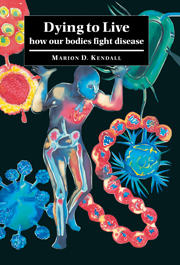1 - Molecules of Distinction
Published online by Cambridge University Press: 29 September 2009
Summary
Rejecting transplants The techniques involved with modern transplantation surgery are very good today, allowing a wide range of organs to be successfully replaced. However, the patient's own body has unique methods of recognising and acting against bacteria, viruses or many foreign invaders in order to overcome them. The same reactions take place against donor organs since they come from a different body, so powerful drugs are used to reduce these natural, usually beneficial, reactions that are potentially harmful in transplantation surgery. Of great importance is the genetic similarity or dissimilarity between donor and recipient. If a group of genes, known as the histocompatibility genes, are identical in both donor and recipient, then there would be no problems of transplant tissue being rejected. Since all individuals inherit some genes from each parent, the resultant genes in the child will not exactly match those of either parent or any brothers and sisters. So, no two individuals, except identical twins where the fertilised egg was split into two, will have the same set of genes (their genetic make-up). Surprisingly, the immune system's cells can recognise the differences and, as a result, the transplant can be destroyed. In order to ensure success after surgery, the body's own immune system must be dampened down to minimise the chances of any cells reacting to the graft and causing rejection. The patient is therefore very susceptible to infections and diseases during this period, and to cancers in the longer term.
- Type
- Chapter
- Information
- Dying to LiveHow our Bodies Fight Disease, pp. 1 - 16Publisher: Cambridge University PressPrint publication year: 1998



